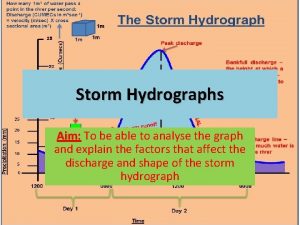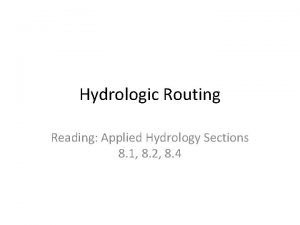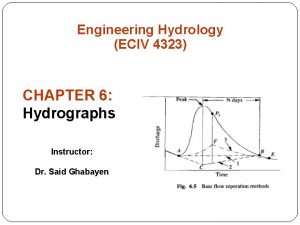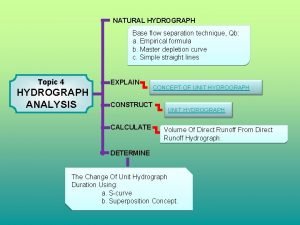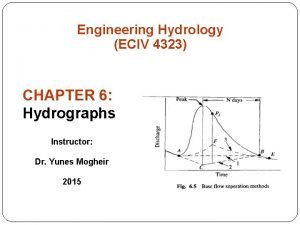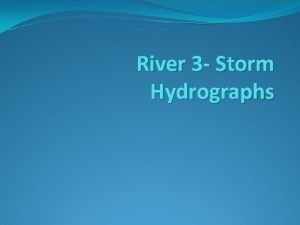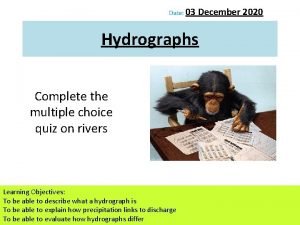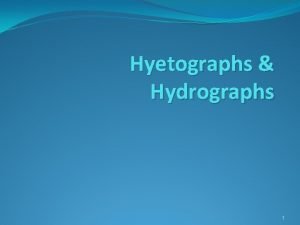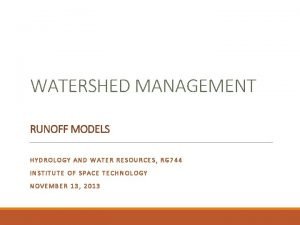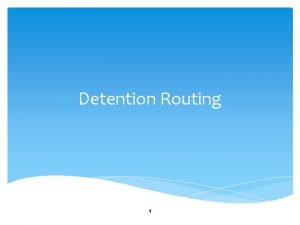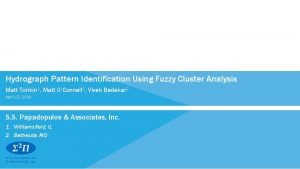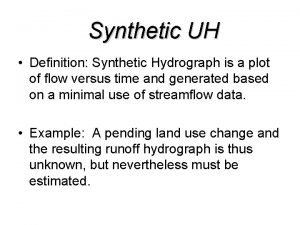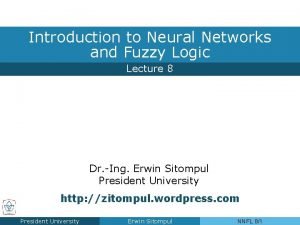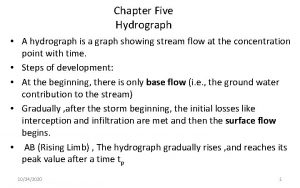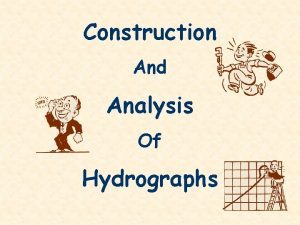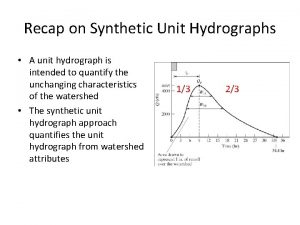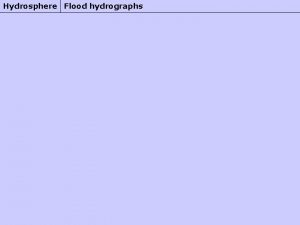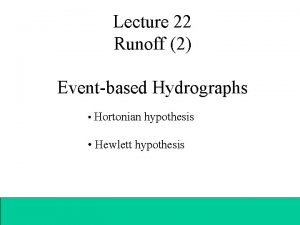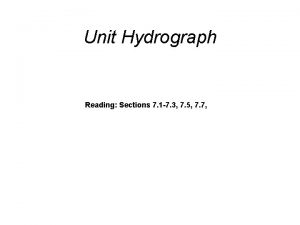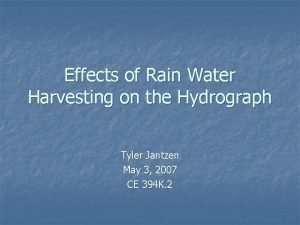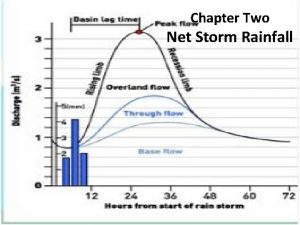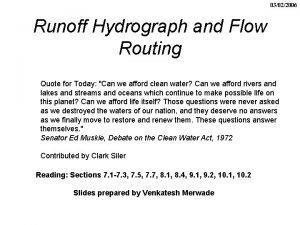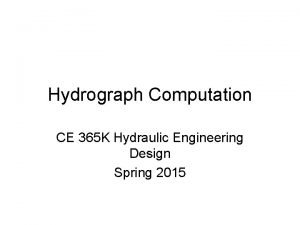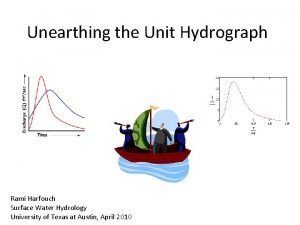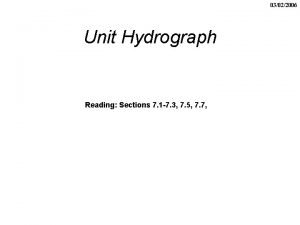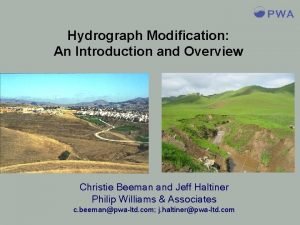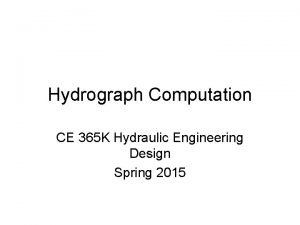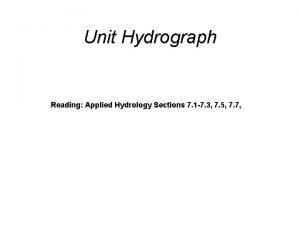1 HYDROGRAPHS LECTURE 11 2 HYDROGRAPHS A hydrograph



























- Slides: 27

1 HYDROGRAPHS LECTURE 11

2 HYDROGRAPHS A hydrograph is a continuous graph showing the properties of stream flow with respect to time Normally obtained by means of a continuous strip recorder that indicates stage versus time (stage hydrograph) and is then transformed to discharge hydrograph by use of rating curve. The term hydrograph generally means discharge hydrograph The hydrograph is a result of the physiological and hydrometerological effects of watershed

COMPONENT ELEMENTS OF HYDROGRAPH 1. Direct surface runoff 2. Interflow 3. Ground water or base flow 4. Channel precipitation 3

4 e Crest Segment Fa llin b im g. L Ris i Con ng lim cen b or trat ion cur v Discharge DEFINITIONS OF HYDROGRAPH Hydrograph in period of no DRO and where no reservoir regulation exists reflects discharge from ground water Point of inflection (where DRO ceases) Point of rise (where DRO starts) Time

RUNOFF FORMATION FROM A RAIN EVENT Precipitation Abstraction Depression storage Detention storage Formation of rivulets 5 Channel flow

FACTORS AFFECTING THE SHAPE OF HYDROPGRAPH Climatic Factors Topographic and geologic Factors Rainfall intensity Catchment size Rainfall duration Catchment shape Distribution of rainfall on the basin Distribution of water courses/ drainage Direction of storm movement Slope of the catchment Geology of the catchment Land use Land cover 6

DIRECTION OF STORM MOVEMENT EFFECT 7

8 SHAPE OF CATCHEMENT EFFECT

9 SHAPE OF CATCHEMENT EFFECT

10 DRAINAGE OF WATERSHED

11 LAND COVER

12 HYDROGRAPH AND TIME RELATIONS Time base: Time from which the concentration curve begins (point of rise) until the direct runoff ceases.

13 HYDROGRAPH AND TIME RELATIONS Lag time or Basin Lag: difference in time between center of mass of effective rainfall and center of mass of runoff produced. Or Time interval from the maximum effective rainfall to peak rate of runoff.

14 HYDROGRAPH AND TIME RELATIONS Time of concentration: the concentration time is the time required, with uniform rain for 100% of a tract of land to contribute to the direct runoff at the outlet. Or the time for runoff to arrive at the outlet from the remote most point after the rain ceased.

15 HYDROGRAPH SEPARATION Hydrograph separation means to separate base flow and DRO in a hydrograph as a basis for further analysis techniques Several methods of base flow separation are used when exact amount of base flow is unknown. Such as Constant Discharge method/ Horizontal line method Constant slope method Fixed base time method Concave method

16 UNIT HYDROGRAPHS Unit hydrograph is a direct runoff hydrograph resulting from one unit (one inch or one cm) of constant intensity uniform rainfall occurring over the entire watershed. The concept of unit hydrograph is based on linear systems theory and follows the principles of superposition and proportionality. It is incorrect to describe a unit hydrograph without specifying the duration, of the storm that produced it An x hours unit hydrograph means a direct runoff hydrograph having 1. 0 inch volume resulting from an x hours storm having a steady intensity 1/x in per hour

17 APPLICATION OF UNIT HYDROGRAPH A unit hydrograph is used for the prediction of flood peak and time to peak in the stream at a particular section due to any amount of effective precipitation Application of an x-hour unit hydrograph to rainfall excess amounts more than 1 unit is accomplished just by multiplying the excess amount by the unit hydrograph ordinates For example, a 3 hours rain event producing 2. 0” effective precipitation would have runoff rates 2 times of a 3 -hours unit hydrograph. Similarly a 3 - hours storm having 0. 5” net precipitation would produce runoff rates half of the 3 hours unit hydrograph. This assumption of proportional flows applies only to equal duration storms

ASSUMPTIONS OF UNIT HYDROGRAPH Following are the assumptions while deriving the unit hydrograph: Precipitation amount and intensity is uniform over the entire watershed Precipitation intensity remains uniform throughout the storm Base length of the hydrograph DRO for a particular catchment resulting from a storm of given duration is approximately the constant Entire watershed is treated as a single unit 18

19 DERIVATION OF UHG Data Collection • To develop a unit hydrograph it is desirable to acquire as many rain fall records as possible • These can be obtained from the published data by meteorological department Preliminary selection • Storms occurring individually , simple storm structure • Storms having uniform distribution of rainfall throughout the rainfall excess period • Storms having uniform spatial distribution of rainfall Further shortlisting • Duration of rain event should be approximately 10 -30% of lag time of the basin • DRO volume should be 0. 5 -1. 75 units • Suitable number of storms should be analyzed to obtain average ordinates Conversion of DRO to UHG • Separation of the components of hydrograph i. e. , DRO and Base flow • Direct runoff ordinates of each storm should be reduced so that each event represents 1 unit of DRO • Final UHG of a specific duration can be obtained by averaging ordinates of selected ordinates

20 NUMERICAL PROBLEM Determine UHG ordinates if effective precipitation is 1. 4 in for this storm. And each time unit is 1. 5 hours. Time (units) Total Baseflow Runoff (cfs) 1 110 7 293 113 2 122 8 202 112 3 230 120 9 160 110 4 578 118 10 117 105 4. 7 666 116 10. 5 105 5 645 11 90 90 6 434 114 12 80 80

21 NUMERICAL PROBLEM Using the hydrograph developed in last problems derive a DRO hydrograph of a storm event as given below. 1. 7” 1. 2” 0. 7” Each time unit is 1. 5 hours

22 CONVERSION OF UHG DURATION Unit hydrograph developed by procedure outlined earlier is applicable only for a specified duration of storm The application to storms of larger or smaller duration might be required sometimes Instead of making hydrograph for the new duration there are two more methods Lagging method S-curve Method

23 LAGGING METHOD The method of “lagging” is based on the assumption that linear response of the watershed is not influenced by previous storms one can superimpose hydrograph offset in time and flows are directly additive if a hydrograph of 1 hour is given, hydrograph for 2 hours duration can be obtained by plotting two 1 hour UHG with second UHG 1 hour lagged, adding ordinates and dividing by two Lagging procedure is restricted to the multiples of the original duration according to the expression D 1=n. D D 1 : possible durations of UHG by lagging method D : Original duration of UHG n : 1, 2, 3, ….

24 S-CURVE METHOD Construction of any duration of unit hydrograph Lagging system is the same as described in last method A unit hydrograph is assumed to repeat indefinitely Continuous lagging of UHG is comparable to a continuously applied rainfall at a certain intensity The cumulative addition of the initial UHG ordinates at time intervals equal to unit storm duration results in a S-hydrograph Maximum discharge of S-hydrograph occurs at time D hours that is less than time base of the storm

25 S-CURVE METHOD

26 S-CURVE METHOD Any duration t UHG may be obtained if we have a D hours UHG Simply lag the first S-hydrograph of D hours UHG by a second S-hydrograph a time interval equal to t hours Subtract the ordinates of second S-hydrograph by the first one And multiply these ordinate with a factor D/t

27 NUMERICAL PROBLEM Give the following 2 -hr UHG, use S-curve procedures to construct a 3 -hr UHG. Time (hours) Q (cfs) 0 0 1 100 2 250 3 200 4 100 5 50 6 0
 What do hydrographs show
What do hydrographs show 01:640:244 lecture notes - lecture 15: plat, idah, farad
01:640:244 lecture notes - lecture 15: plat, idah, farad Hydrograph
Hydrograph Drainage basin system
Drainage basin system Storm hydrograph
Storm hydrograph The basic assumptions of the unit-hydrograph theory are
The basic assumptions of the unit-hydrograph theory are Natural hydrograph
Natural hydrograph Ce424
Ce424 The basic assumptions of the unit-hydrograph theory are
The basic assumptions of the unit-hydrograph theory are Storm hydrograph definition
Storm hydrograph definition Flashy and flat hydrograph
Flashy and flat hydrograph Hyteograph
Hyteograph Direct runoff hydrograph formula
Direct runoff hydrograph formula Outflow hydrograph
Outflow hydrograph Passaic river flood gauge
Passaic river flood gauge Convolution formula
Convolution formula Hair hydrograph
Hair hydrograph Unit hydrograph
Unit hydrograph Teaching methods definition
Teaching methods definition Watching lecture than watching at at
Watching lecture than watching at at Data mining lecture notes
Data mining lecture notes Physics 111 lecture notes
Physics 111 lecture notes Fiche de lecture master
Fiche de lecture master Stanislas dehaene lecture
Stanislas dehaene lecture Scope of pharmacognosy
Scope of pharmacognosy Membership function fuzzy logic
Membership function fuzzy logic Lecture theatre
Lecture theatre Drawing lecture
Drawing lecture
